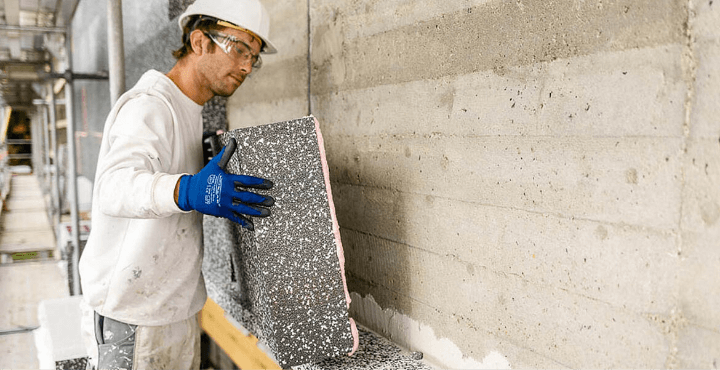
PU adhesive foam for bonding and insulating
PU foam insulates, seals and bonds. As the name suggests, PU adhesive foam adheres very well. This is why it is also called PU adhesive. It is most frequently used for mounting thermal insulation composite systems (TICS).
About 80 percent of all façades in Germany are insulated with PU foam. Professionals use PU adhesive foam to attach the insulation panels to masonry, façades, cellar ceilings and flat roofs. PU adhesive also has very good thermal insulation values of between 0.26 and 0.04 W/(mk). The TICS adhesive foam acts as a second insulating layer between the insulation panel and the wall of the building. As a result, the insulation can be mounted free of thermal bridges.
Advantages of PU adhesive

The advantage of polyurethane adhesive foam over other cement-based adhesives is that it hardens quickly and the fitter does not require any additional tools. After just two to three hours, work can continue on walls mounted with PU adhesive. In contrast, cement-based adhesives must dry out for three to four days before the next work steps are possible. When choosing the right adhesive foam, manufacturers recommend using foams that do not expand too rapidly. This ensures that the insulating elements do not shift in an uncontrolled manner whilst the PU foam hardens and expands.
Observe the building approval
It is also important to check that the foam is officially approved for use with the TICS. Approval is also required for PU adhesive foam to be used for grouting non-load-bearing walls. Partially-collapsing foams are the right choice in this case.
How you can avoid thermal bridges
While PU foam is optional for TICS mounting, it is a must for filling open joints. To avoid thermal bridges on the façade, specialists must install the insulation panels precisely with tightly pressed butt joints. However, regardless of how precisely the panels are installed, joints cannot always be avoided. These need to be filled in carefully later on, so that the 'full insulation' can live up to its name.
Adhesive mortar may never be used for filling because this will create thermal bridges. Instead, smaller gaps are insulated with PU foam. Likewise, these need to be approved by the manufacturer of the TICS for this application. In the case of larger gaps, polystyrene strips are cut to size and placed in the joint.
Adhesion of WDVS boards with PU foam – The most important tips
Use the correct foam for adhesion
The construction foam of your choice should be officially approved for use with your WDVS boards. Usually, minimally expanding construction foams are used to attach WDVS.
Why is this important?
If the foam continues to expand significantly after installation, your WDVS boards may move after they have been attached. If the foam does not expand as significantly, they remain precisely where you want them to be.
Create a W shape in a square

To ensure that the boards stay firmly in position and offer perfect insulation, most manufacturers recommend foaming the edges of the board in a square and then applying a large W shape in this area.
This allows you to ensure that about 40 percent of the board is covered with adhesive after you have attached the board to the object and pressed it into position. Also, no air can circulate behind the adhered boards later. In this case, this would have a negative affect on the thermal insulation effect.
Some suppliers recommend other foam distribution methods on the boards for their products. As always, it is always worth checking the processing instructions on the packaging or in the product data sheet.
Wait for about one minute after applying the PU adhesive
After this, the adhesive is form-stable and you can adhere the board. You can still adjust the position within the next minute. All other connection work can be carried out after a further two hours.
Ensure that the temperature and moisture is correct
As always when working with PU foam, the temperatures should not lie below five degrees so that the foam can activate correctly.
When working with 1-K foam, it is recommended that you slightly moisten either the foam itself or the surfaces that are to be adhered. This ensures that the foam has enough moisture to harden.
Other application options of adhesive foam
In addition to mounting thermal insulation systems, PU adhesive can be used quite universally. Two examples of this are bonding non-load-bearing interior walls and bonding flowerbed edgings made of natural stones. Adhesive foam replaces classic cement.
Adhesive foam is supplied in customary pressurised cans as adapter foam or pistol foam. Like all other PU foam cans, the spent cans can be returned free of charge for recycling at PDR.
PU adhesive foam should not be confused with assembly adhesive. The latter is supplied in plastic cartridges or tubes. Assembly adhesive is always your first option if you want to avoid drilling, screwing and nailing; for example, when mounting a mirror in the bathroom. Assembly adhesive is available in various chemical compositions, including a PU-based composition, but it is not actually considered a PU foam.

![[Translate to Englisch:] Fassadenaußendämmung mit PU-Kleber [Translate to Englisch:] Fassadenaußendämmung mit PU-Kleber](/fileadmin/PU-Schaum-Center/PU-Schaum_in_der_Praxis/Anwendungsgebiete/t_fassadenaussendaemmung.jpg)
![[Translate to Englisch:] PU Schaum, Sicherheit [Translate to Englisch:] PU Schaum, Sicherheit](/fileadmin/PU-Schaum-Center/PU-Schaum_in_der_Praxis/img_sicher_arbeiten_mit_PU-Schaum.jpg)
![[Translate to Englisch:] Energie sparen, PU Schaum [Translate to Englisch:] Energie sparen, PU Schaum](/fileadmin/PU-Schaum-Center/Energie_Nachhaltigkeit/img_energie_sparen.jpg)

